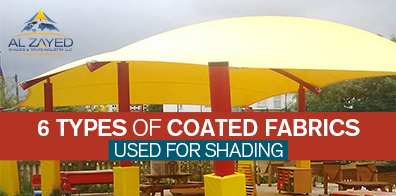
The sultry weather of UAE constantly entails that the sun will shine brightly on most days of the year. Due to such bouts of scorching heat, people constantly seek out tents and shading options to save themselves from the extreme weather conditions faced by the UAE region. To save their cars from flaring up, car-parking shades in Dubai are proliferate across the country. With a wide range of coated fabric options available, each touting its own merits and cons, it can become extremely difficult to choose the right fabric for your needs. Here are six major types of coated fabrics that are popularly used for this purpose:
A combination of PVC and polyester is widely used across the building industry because it strikes a great balance between price and performance. PVC coated polyester fabrics are suitable for structural applications, such as deployable structures, due to its resistance to flex cracking. Long-term stability, resistance to soiling and its lightweight makes for an ideal fabric, especially when you coat it with the right coating, which further serves to enhance its capabilities. These types of coating fabrics were used in the London Olympics, since it is perfect for erecting temporary pavilions.
When it comes to the durability of materials, nothing can beat the glass fiber fabric, especially when it is coated with PTFE. Its extensive life makes it a perfect choice for permanent use and for projects boasting a service life of more than two decades. Combine the mechanical resistance of glass fibers with a high resistance to soiling, and you can safely venture to say that it can last over two decades. Its durability more than makes up for the high cost of PTFE coated Glass fiber fabrics. It might not be a good choice however for low budget temporary projects.
THV is a polymer that is fabricated from a wide number of monomers. THV materials can be processed after melting to create turbing with a high degree of optical clarity. One of the recent changes that we have seen is the change in coating over Polyester fabric. PVC coating has recently been replaced by THV coating and polyester fabrics with THV coating are now used profusely in the building industry. THV has some advantages over PVC coating. Some of them are self-cleaning capabilities, UV resistance and weather protection. Additionally, you can use the same process and equipment as you would for PVC coating to coat a polyester fabric with THV.
The biggest downside of PTFE coated fabrics is that they are susceptible to wrinkles. Thankfully, you can easily get over this weakness with silicone treated with the right additives. Silicone has one of the best cracking performance and exhibits brilliant resistance against chemical attacks and UV radiation. Due to its complex manufacturing process, it lies on the pricier end of the spectrum, which is why it is rarely used in architectural applications. It is mostly employed for permanent applications.
PU stands for Polyurethane, which is a material prepared from a synthetic woven base fabric. The coating is only applied to one side of the fabric, enabling the finished product to be lightweight, water resistant and flexible. Polyurethane coated nylon fabrics are known for their extreme flexibility, but the poor mechanical performance of nylon fabric restricts its use to small projects only. On the positive side, the coating is easy to weld. You can boost the mechanical performance by replacing nylon with polyester fabric.
Coated PTFE fabrics exude an extremely high flex cracking ability, promises long term stability and depicts resistance to soiling, which render it a great option for long lasting projects. Its exorbitant price tag and complex manufacturing process restricts its use. If you are working under a shoestring budget, you can opt for the uncoated version, which costs much less and is great for convertible structures. It is used at the façades of the clusTEX research pavilion in Milan and also the NRW Bank travelling exhibition ship.
In order to choose the right coated fabric for your shading needs, you need to understand the advantages and disadvantages of each fabric. Every coated fabric has some unique qualities that make it perfect for a specific purpose. This article might have helped you finalize your choice. Access your shading needs and choose the right fabric that fulfills your needs perfectly without making any compromises.
Which type of coated fabrics have you experimented with for your shading needs, and why? Feel free to share it with us in the comments section below.